What is Transportation of Concrete?
Transportation of concrete is a way to move fresh concrete from where it is mixed to where it will likely be used in the structure. Since the time it takes to move concrete depends mostly on how long it takes to set up at first and how much workability is needed at the site, it should be a design parameter. The method of moving concrete is decided ahead of time so that the right additives can be added to improve certain properties.
Importance of Transporting Concrete:
The planning and execution of concrete transportation must be meticulous. For temporary jobs, thirty minutes of travel time is usually sufficient. Concrete should be unloaded from agitating transport equipment at a ready-mix plant or other central or mobile plants within two hours. This time is cut in half if the silent transport vehicles are utilized. To avoid honeycombing or chilly joints, you should not wait around. If you choose the wrong way to transport concrete, it could get mixed up and be useless. So, the right way must be chosen to move the concrete based on the needs. There are many things to think about when choosing how to transport concrete, such as:
- Type of concrete mix and its parts
- Conditions of the weather, like humidity, temperature, wind speed, etc.
- Size of building, Type of building
- Topography
- Position of the batching plant
- Price of transportation
Methods for Transportation of Concrete:
Some of the most common methods of transporting concrete are as follows:
1. Mortar Pan:
In our country, the mortar pan method is widely employed, particularly for smaller projects where only small amounts of concrete must be transported. This approach requires more effort. Even though this method exposes a more concrete surface area for dry conditions in thick members, the risk of concrete segregation is greatly reduced. The high concrete surface area exposed to the environment during hot weather leads to significant water loss. Most construction projects may be done on the ground, underground, or air using this technology with little additional effort.
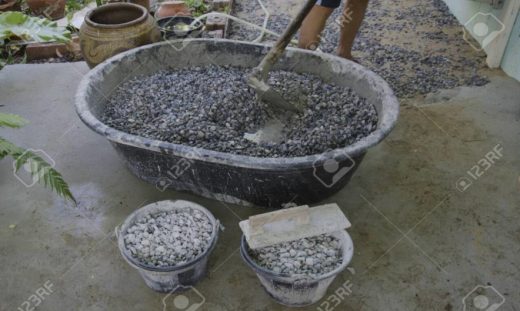
Fig 1: Mortar Pan
Courtesy: 123rf.com
2. Wheelbarrow:
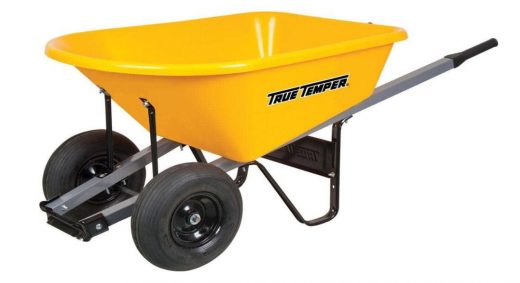
Fig 2: Wheelbarrow
Courtesy: homedepot.com
Concrete can be moved around on the ground with the help of a wheelbarrow. It’s as common a method as the mortar pan for delivering ground-level concrete. Pneumatic wheels can be installed on wheelbarrows to reduce the chance of concrete splitting during transport over long distances or on uneven ground.
3. Crane, Bucket, and Ropeway:
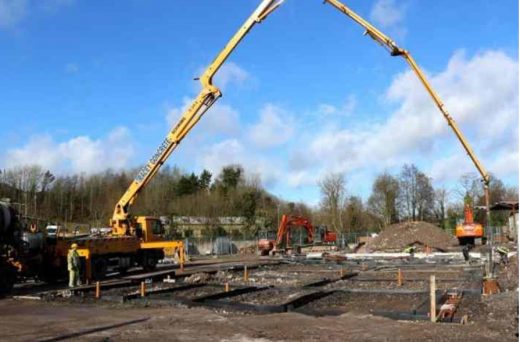
Fig 3: Crane, Bucket and Ropeway
Courtesy: civiconcept.com
When constructing skyscrapers, cranes come in quite handy. Cranes are quick and flexible, allowing the horizontal and vertical concrete transfer. Both buckets and skips with the green concrete mix are transported by cranes; the latter feature a discharge door at the bottom, while the former requires a tilting operation to be emptied. The bucket’s 0.5 cubic meter volume is suitable for moderate tasks.
Most concrete work, such as the building of dams and bridges, requires using a ropeway and buckets to move the heavy material from one place to another. Here, concrete is mixed on the bank and then transported in a bucket using a pulley or other mechanism to where it will be discharged. Steel towers are set up on the riverbank to create tension for the rope.
4. Belt Conveyor:
It isn’t very useful for making concrete because it can separate on steep slopes, at roller points, and when the direction of the belt changes. Separation can also happen when a rubber belt moves back and forth.
Modern belt conveyors can have a moving diverter, a reach that can be changed, and speeds that can be changed forward and backward. Conveyors can quickly move a lot of concrete where access is limited, and portable belt conveyors are used for short distances or lifts. The end discharge must stop the mortar from getting separated and eliminate all the mortar on the belt’s return. It also means that too much concrete is exposed to the environment.
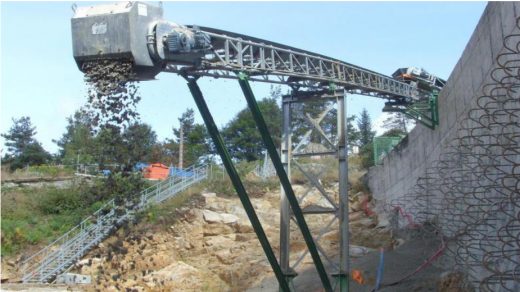
Fig 3: Belt Conveyor
Courtesy: tecnitudet.com
5. Truck Mixer and Dumper:
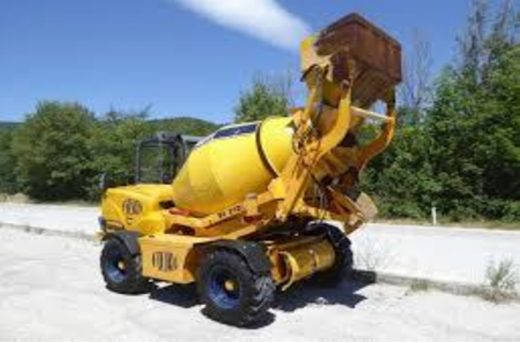
Fig 5: Truck Mixer and dumper
Courtesy: mmtequipment.com
Trucks, dumpers, and other open-body lorries can be used to move concrete quickly and cheaply for up to about 5 km. Most dumpers can hold 2 to 3 cubic meters, while a truck mixer can hold up to 4 cubic meters. Before loading the concrete mix into the vehicle’s body, water should be sprayed. During transport, wet concrete should be covered with tarps or other covers to keep it from drying out and getting stiff. Slowly mixing things, the agitators help a lot.
6. Chute:
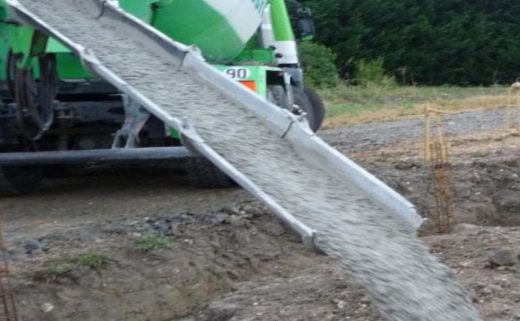
Fig 6: Chute
Courtesy: loutec.com
A chute can move concrete from the ground level to the lower level. It is used in places like trenches where there isn’t enough room for workers to reach the concrete. The surface should have at least one vertical to 2.5 horizontal slopes, but no more than that. Concrete can form a slightly dense mass without separating or segregating.
7. Skip and Hoist:
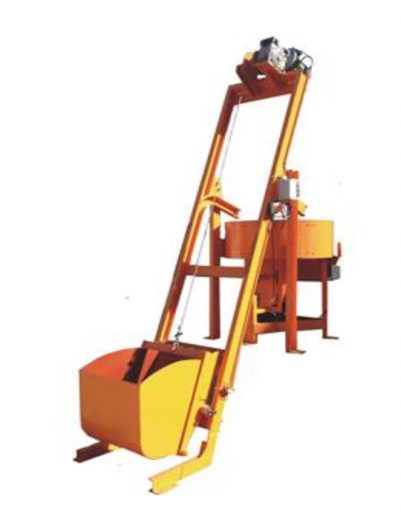
Fig 7: Skip and Hoist
Courtesy: robustmachine.co.za
This method moves concrete vertically upward for buildings with more than one story. At ground level, the mixer goes straight into the skip. The skip went up over the rail until it reached the casting level. In a multi-story building where the time it takes to move the skip and dump the concrete mix is based on the size of the skip and the number of units, large skips with a single unit are given. When one skip moves, the other one is filled with concrete. It makes the whole process run more smoothly.
8. Transit Mixer:
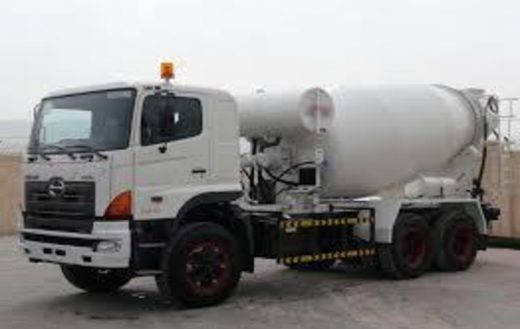
Fig 8: Transit Mixer
Courtesy: kiconeequip.com
The transit mixer is one of the most popular tools for transporting concrete over long distances, mostly in the RMC plant (Ready Mixed Concrete plant). The transit mixer is mounted on the truck and can hold between 4 and 7 m3. With 2 to 6 turns per minute, the truck always moves the concrete around. A small pump is attached to the back of a truck mixer to let the concrete out. Concrete can be put into the mixer, either dry or wet. If the mix is wet, it must get to the site in one to one and a half hours.
9. Pumps and Pipelines:
It’s the most laborious method, but it’s the only one that works well when space is at a premium or when a significant volume of concrete needs to be poured without using cold joints. Between 8 and 70 cubic meters per hour, concrete can be pumped. Distances (in the horizontal plane) are roughly 300 meters, and those (in the vertical plane) are roughly 90 meters.
The pipe diameter is typically between 8 and 20 cm and can be made of steel, plastic, or aluminum. For pumped concrete, the slump value must be at least 40 to 100 mm, or 0.90 to 0.95 compacting factor. While developing the mix, it is important to remember that compaction at the delivery site can limit workability by as much as 25 percent.
Conclusion:
Concrete is easy to make, but the concrete made in a mixer needs to be moved to where it will be used, which is a very important step. The most important thing is to transport concrete correctly because that affects the quality of the concrete. Concrete should be brought to the construction site a certain amount of time before it starts to set. If the distance is long or the time is long, handling the concrete may cause it to separate and lose its slump.
References:
1. “What Is Transportation and Methods Adopted for Transportation – Zillions Buyer.” Zillions Buyer, 17 July 2020, www.zillionsbuyer.com/blog/what-is-transportation-and-methods-adopted-for-transportation-of-concrete.
2. “How to Choose the Best Method of Transporting Concrete.” The Concrete Network, 19 Oct. 2018, theconcretenetwork.co.uk/choose-best-method-transporting-concrete.
3. Steffen, John. “Transportation of Concrete and Its Importance – ConstructUpdate.com.” ConstructUpdate.com, 24 June 2017, www.constructupdate.com/transportation-concrete-importance.
4. “Transportation of Concrete and Checklist for Concrete Transportation.” Mastercivilengineer, 19 May 2021, mastercivilengineer.com/transportation-of-concrete-and-checklist-for-concrete-transportation.
5. “Transporting of Concrete.” BrainKart, www.brainkart.com/article/Transporting-of-concrete_3678. Accessed 29 Sept. 2022.
6. “All House Related Solutions – GharPedia.” All House Related Solutions – GharPedia, gharpedia.com/blog/method-for-transportation-of-concrete. Accessed 29 Sept. 2022.
If you have a query, you can ask a question here.



reference made was so smart.it helps
alot in learning.thank you for your research.